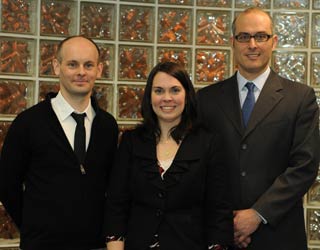College Site | Development | TOC - Department Dev Sites | CLHS TOC | Center for Law, Health & Society | News and Events | Center News | Combating Human Trafficking Combating Human Trafficking
February 23, 2010
 A modern form of the slave trade, human trafficking subjects millions annually to violations of human rights by forcing adults and children into the sex industry or labor settings, including sweatshops, farms, and domestic servitude.
A modern form of the slave trade, human trafficking subjects millions annually to violations of human rights by forcing adults and children into the sex industry or labor settings, including sweatshops, farms, and domestic servitude.
Over 100 attendees joined the Center in February for a panel comparing human trafficking in the U.S. and Australia. Professor Jonathan Todres highlighted the U.S. situation, and Dr. Andreas Schloenhardt, a law professor with The University of Queensland in Brisbane, compared Australian policies.
Center associate director Jerri Nims Rooker moderated the program. She explained that laws and policies to combat human trafficking fall within the "three Ps" - prosecution of the traffickers, protection of the victims, and prevention of the global trade in persons.
Schloenhardt explained that most countries, including Australia in 2005, only recently adopted laws criminalizing human trafficking. As a result, the number of prosecutions is low.
Todres compared measures adopted by the U.S., which enacted the Trafficking Victims Protection Act (TVPA) in 2000. He noted the TVPA established T-visas to enable foreign trafficking victims to access social services and now offer an avenue for permanent residency.
In contrast, Schloenhardt said protection of victims has only come about in the last two years in Australia. Prior to that, its government opposed granting immigration status to victims.
When Nims Rooker asked about steps to prevent the tide of human trafficking, Schloenhardt said, "Raising awareness is a simple step." However, reducing demand may not be a realistic goal. "There is and always has been a demand for paid sexual services," he stated. He said a fundamental policy difference is that Australia has a legal sex industry in an effort to regulate the demand, whereas the U.S. does not support legalized prostitution.
Todres said that more research is needed to develop more sophisticated prevention strategies. Engaging sectors of society beyond law enforcement and social services can help identify trafficking victims, he said. "When pimps take girls or boys to an emergency department to get necessary care, they are protecting their investment. From our standpoint, that's a window of opportunity to help victims."